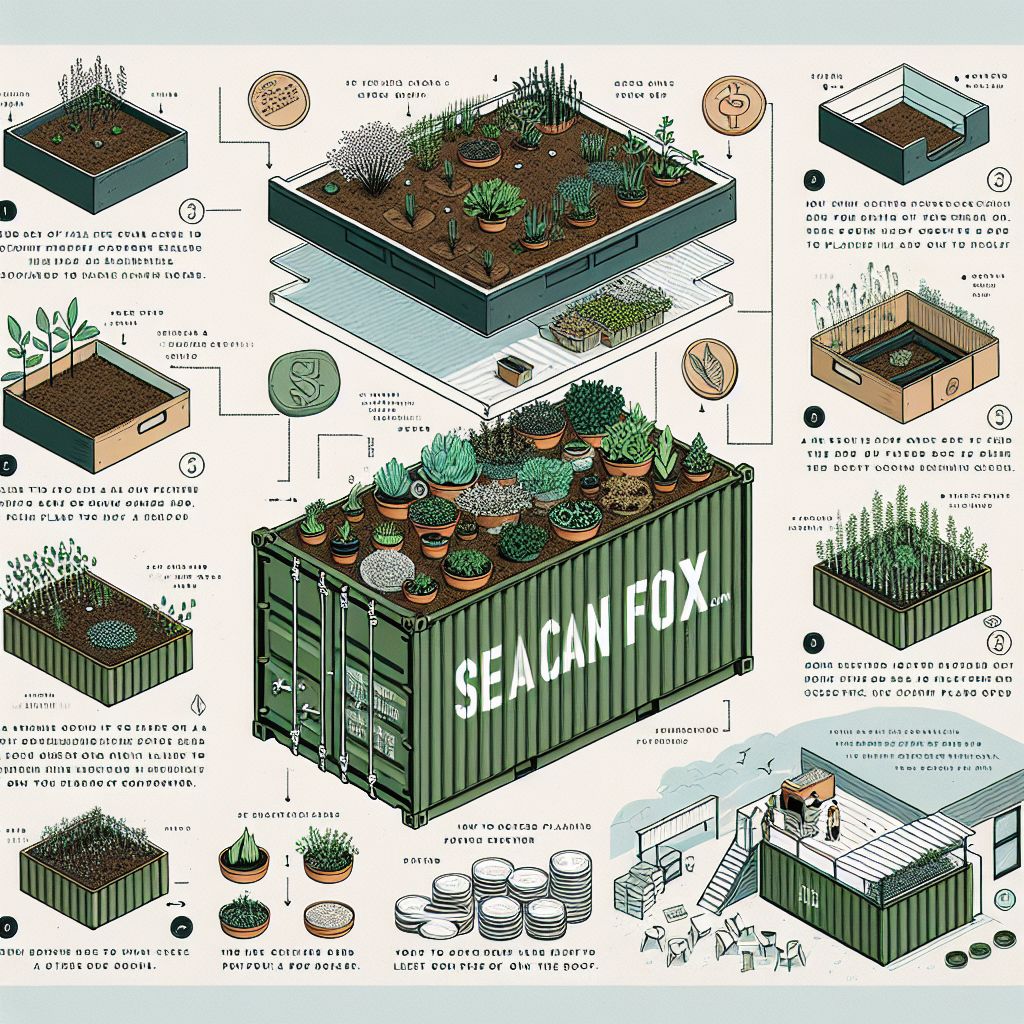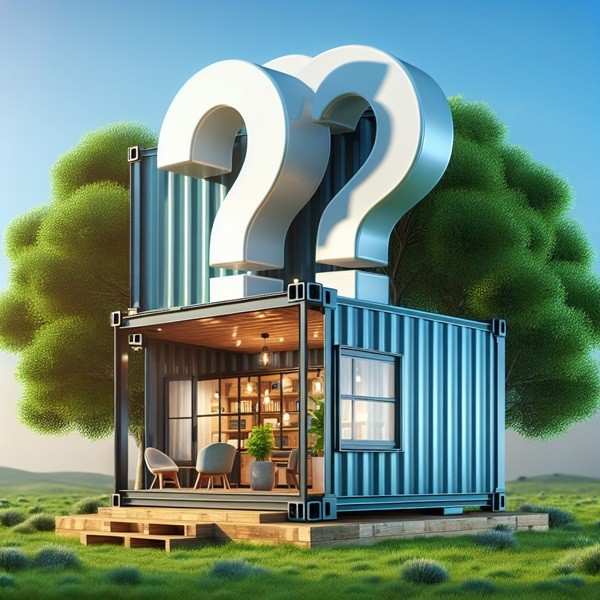
Key Takeaways
- Discover how a shipping container can become a lush rooftop garden.
- Learn the essentials of planning, from assessing structural integrity to selecting the right plants.
- Understand the importance of soil preparation and how to create the perfect growing medium.
- Get practical tips on maintenance to keep your garden flourishing.
- Break down the costs: expect to spend between $1,000 and $2,100 for a basic setup.
Transforming Shipping Containers Into Lush Roof Gardens
Don’t let limited ground space limit your green ambitions. Look up, and use that empty rooftop as your canvas for gardening. It’s a perfect way to maximize every square inch of your urban dwelling.
Blueprint for a Blooming Roof
Assessing Load-Bearing Capacity
First things first: safety. Your shipping container roof must be able to support the weight of a garden. This includes the soil, plants, water, and any humans who’ll be tending to the plants. Consulting a structural engineer isn’t just a good idea—it’s essential.
My Favorite Container Homes Resource
I compared the top 3 Container Home Guides
to discover the ultimate resource!
See my top recommendation here
Designing a Functional Layout
Now, let’s talk design. You want a garden that’s not only beautiful but also practical. Think about accessibility for maintenance, how you’ll manage water runoff, and what kind of plants will thrive up there. Remember, the goal is to create a space that’s both a sanctuary and a functional garden.
Climate Considerations for Roof Gardens
Let’s talk climate because it’s a big deal for your rooftop garden. You’ve got to choose plants that can handle the highs and the lows of your city’s weather. If you’re in a place that gets super hot, think about succulents or drought-resistant greens. If it’s often cool, go for plants that can handle a chill. And no matter where you are, make sure your plants can stand up to the wind—it can get pretty gusty up there on the roof.
Choosing the Right Greens
Now, for the fun part—picking your plants! You want a mix that’s not only tough but also brings joy and maybe some tasty treats. Herbs are a no-brainer—they’re hardy, useful, and they smell amazing. Small veggies like cherry tomatoes or strawberries can add some fresh flavor to your meals. And don’t forget flowers; they’ll give your garden a pop of color and can attract helpful pollinators like bees and butterflies.
The Dirt on Soil and Planting
Soil isn’t just dirt—it’s the lifeblood of your garden. You need the right mix that’s light enough for your container to handle but rich enough to feed your plants. Look for a soil mix that’s made for containers or rooftop gardens. It’ll drain well so your plants won’t get waterlogged, but it’ll also hold onto enough moisture to keep them happy.
Creating the Ideal Growing Medium
Good soil is a blend of different things. You’ll want compost for nutrients, perlite or vermiculite to help with drainage, and peat or coconut coir to hold moisture. Mix it all up, and you’ve got a growing medium that’s just right for container gardening.
Planting and Nurturing Techniques
- Start with seedlings or young plants to get a head start on the growing season.
- Space your plants out based on their mature size—crowding them won’t do them any favors.
- Water them in the morning or evening when the sun isn’t as intense, so they get the most out of it.
Remember, your plants are counting on you to give them what they need. Water them regularly, but don’t overdo it—nobody likes soggy feet. And give them some food with organic fertilizers or compost tea every now and then to keep them growing strong.
It’s not just about throwing plants up there and hoping for the best. You’ve got to be a bit of a plant parent—watching, learning, and adjusting as you go. You’ll get to know your garden, and you’ll figure out what works best for you and your green buddies.

Keeping Greenery Thriving
Once your plants are in, it’s all about keeping them happy. That means regular check-ins, a bit of pruning, and keeping an eye out for any pests or problems. It’s like having a bunch of little friends living on your roof—you’ve got to look after them!
Scheduled Watering and Organic Feeding
Water is life, especially for your rooftop crew. Set up a schedule to make sure they get a drink when they need it. And when you feed them, go organic. It’s better for them, better for you, and better for the planet.
Natural Pest Control and Disease Prevention
Bugs and diseases can sneak up on you, but don’t reach for the chemicals just yet. Try natural options first, like neem oil or insecticidal soap. And keep your plants healthy—they’ll be better at fighting off pests and diseases on their own.
Managing a Roof Garden on a Budget
Building a garden on top of a shipping container doesn’t have to drain your wallet. With some smart shopping and a bit of DIY, you can create a green retreat without breaking the bank.
Scout out sales and discounts at your local garden center or online. You can often find deals on soil, plants, and other supplies. And don’t forget to ask around—friends, family, and neighbors might have cuttings or tools they can share.
DIY can be your best friend when it comes to gardening on a budget. Building your own planters, creating a watering system from recycled materials, and making your own compost can save you a ton of cash. Plus, it’s pretty satisfying to look at a thriving garden and know you built it with your own two hands.
Material Shopping List
To get you started, here’s a shopping list for your container roof garden:
- Quality soil mix
- Compost for nutrients
- Perlite or vermiculite for drainage
- Seeds or seedlings of your chosen plants
- Planters or containers with good drainage
- Basic gardening tools like a trowel and pruning shears
- Organic fertilizer or compost tea
- A watering can or hose with a fine spray setting
With these supplies, you’ll be well on your way to creating a garden that’s as good for the earth as it is for your soul. So roll up your sleeves, get your hands a little dirty, and start growing up!
At-a-Glance Summary: Creating A Roof Garden
| Topic | Details | References |
|---|---|---|
| Structural Considerations | Assessing load-bearing capacity, ensuring proper drainage | 1, 2, 3 |
| Plant Selection | Edible plants (vegetables, herbs, fruits), ornamental plants (flowers, shrubs, succulents), incorporating native and drought-tolerant species | 2, 4 |
| Budget Estimation | Soil and growing medium: $300-$500, Plants: $200-$400, Planters and materials: $150-$300, Structural reinforcement: $200-$500, Water collection and storage: $200-$400 | 2, 4 |
| Maintenance and Care | Watering and fertilizing, pest and disease management, seasonal maintenance tasks | 2, 4 |
| Advantages and Disadvantages | Advantages: Adds greenery, food production, visual appeal; Disadvantages: Waterproofing, time-consuming maintenance, susceptibility to pests and diseases | 5 |
Checklist
- Consult a structural engineer for load-bearing capacity
- Choose a suitable design and layout for your garden
- Select plants based on your local climate and rooftop conditions
- Prepare the ideal soil mix for container gardening
- Set up a regular watering and feeding schedule
- Implement natural pest control measures
- Plan your budget and gather necessary materials
- Regularly maintain your garden for health and productivity

Frequently Asked Questions (FAQ)
How do I start a roof garden on a shipping container?
Starting a roof garden on a shipping container involves several key steps: assessing the structural capacity of the container, designing a layout, selecting appropriate plants and soil, and setting up a watering system. It’s important to ensure that the container can support the weight of the garden and that you have a plan for drainage and plant maintenance.
What plants are best suited for a container roof garden?
The best plants for a container roof garden are those that can tolerate the specific conditions of your rooftop environment, including exposure to sun, wind, and varying temperatures. Hardy herbs, small vegetables, and drought-resistant varieties are excellent choices. Always consider the mature size of the plants to avoid overcrowding.
Can I set up a roof garden by myself or do I need professional help?
While it’s possible to set up a roof garden on your own, especially if you’re handy and have some gardening experience, it’s advisable to consult with a structural engineer to ensure the safety of your garden. For complex designs or if you’re unsure about the process, professional help might be necessary.
What is the average cost of setting up a shipping container roof garden?
The average cost of setting up a basic shipping container roof garden ranges from $1,000 to $2,100. This estimate includes soil, plants, planters, structural reinforcements if needed, and a water management system. The final cost can vary based on the complexity of the project and the materials chosen.
How do I maintain the plants on my shipping container roof garden?
Maintaining your container roof garden involves regular watering, feeding with organic fertilizers, pruning, and monitoring for pests and diseases. It’s also important to ensure that the plants have adequate drainage and are not exposed to extreme conditions without protection.
Remember, the key to a successful container roof garden is planning, care, and a bit of creativity. With the right approach, you can transform your shipping container into a verdant paradise that provides fresh air, food, and a beautiful retreat from the urban hustle. Happy gardening!





